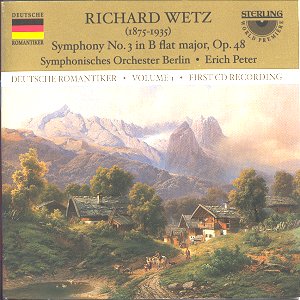Richard WETZ (1875-1935)
Symphony No. 3 (1920-22)
 Symphonisches Orchester/Erich
Peter
Symphonisches Orchester/Erich
Peter
rec Jesus-Christus-Kirche, Berlin-Dahlem, 28-31 Aug 1981, RIAS, Berlin
DDD
originally issued on an Ars Musici LP in the early 1980s
Deutscher Romantiker series vol. 1
 STERLING CDS-1041-2
[58.46]
STERLING CDS-1041-2
[58.46]
BUY NOW
Crotchet
AmazonUK
AmazonUS
Amazon
recommendations

Bo Hyttner's steadfast dedication has borne fruit in one of the most polished
and discerning of catalogues primarily centring on his native Swedish romantics
but also branching outwards towards Swiss and now German branches of the
great tradition.
Wetz was born into comfortable but quite unmusical surrounding in Upper Silesia
in 1875. In 1897 he entered the Leipzig Conservatorium where he was taught
by Jadassohn and Reinecke. Ludwig Thuille (whose 1886 symphony and 1901 piano
quintet should be worth a look) taught him in Munich. Weingartner became
one of Wetz's leading protagonists. Attempts to find a career niche in the
German theatre system miscarried. With 100 or so lieder to his name Wetz
produced two operas to his own libretti: Judith and The Eternal
Fire. The Erfurt Music Academy and Musikverein appointed him Director
and there he stayed 1906-1925 reviving rare works by Liszt and Draeseke amongst
many others. At the age of 40, like Bruckner, he embarked on the first of
his three symphonies. The first was written in 1917, the second, 1920 and
the third in 1923. He also wrote books on Bruckner, Liszt and Beethoven.
There are two string quartets that should be worth appraisal. His musical
education had not exposed him to outrageous influences from Scandinavia or
France and he remained a determined exponent of the high Teutonic romance.
The Third Symphony has the necessary tension and foreboding to hold attention
though 'architecturally' it tend to sprawl. Impressions that remained include
a style close to Bruckner and Schumann and a delightful way with pizzicato
technique. The epic rolling romantic swell of (18.15) the opening langsam
is followed by the toiling intensity and the louring soliloquising of
the second movement. There is magic here as in the whispering slow snowy
drifts of the last few minutes of the sehr langsam - strings against
French horn.
Erich Peter's strings, though by no means strangulated or chaotic, lack the
luxury and plushness that would have given the first two movements a real
'following wind'. The glimmering scherzo is not entirely a delicate cross-play
though Wetz contrives many lucid 'supernatural' effects in rustic Mahlerian
Ländler style. There are moments here that closely recall the Franz
Schmidt Hussar Song Variations. From the same era comes the bel canto
lyrical inspirations of Joseph Marx in his Natur-trilogie and
Herbstsymphonie (surely 'naturals' for Sterling) and Rued Langgaard's
grandiloquent Schumann-re-flowering symphonies. The scherzo reminded me of
Siegfried Wagner (see CPO series). The light-hearted merry-go-round is left
behind in the finale for the long yearning lines explored in the first two
movements. This is no lilting showcase - its concerns and motive force are
serious. Rachmaninov's Second Symphony and Haakon Børresen's Second
and Third all have their similarities with this music but time and again
it is the grim Brucknerian set to the jaw that asserts its spell over the
music. The 'last great German symphony' claims the notes? Well …not
quite but … without doubt this is an ambitious statement in the German
romantic tradition - confident, sturdy and resolute.
I am not familiar with the name of this orchestra. Was this a specially formed
orchestra rather like Wyn Morris's Symphonica of London for those Delysée
LPs of Mahler symphonies and Sidney Sax's National Philharmonic for the RCA
Classic Film Music series. Unanimity and refinement of string tone are not
consistently perfect but the results certainly excel serviceable. There is
a sense of missionary occasion about those three session days in a Berlin
church during the summer of 1981. The odd creak and extraneous noise somehow
intensifies the experience of discovery.
Excellent notes by Wolfgang Gottschalk in German, English and French. There
are 12 music exx.
The other two WETZ symphonies are there for the hearing on CPO. It is typical
of Sterling's enlightened and unselfish attitude that the booklet carries
details of the first and second symphonies available on CPO.
Enthusiasts step forward. What next? Can we hope for the complete symphonies
of Draeseke, Thuille's symphony, Marx's Castelli, Herbst-Symphonie and
Naturtrilogie (urgent imperatives every one), August Bungert's operatic tetralogy
'Homerische Welt' and his symphony 'Die Erstes Fahrt Zeppelin'. The
German-speaking tradition has hardly been scratched.
Rejoice for now in another gold-liveried addition to the Sterling stable.
Rob Barnett
MORE WETZ
WETZ Symphony No. 1
Cracow PO/Roland Bader
CPO
999 272-2 DDD 1994
WETZ Symphony No. 2
Staatsphilharmonie Rheinland-Pfalz/Werner Andreas Albert
CPO
999 695-2 DDD 1999 review

